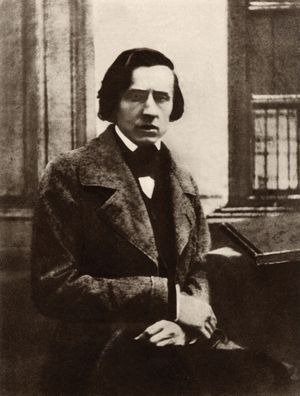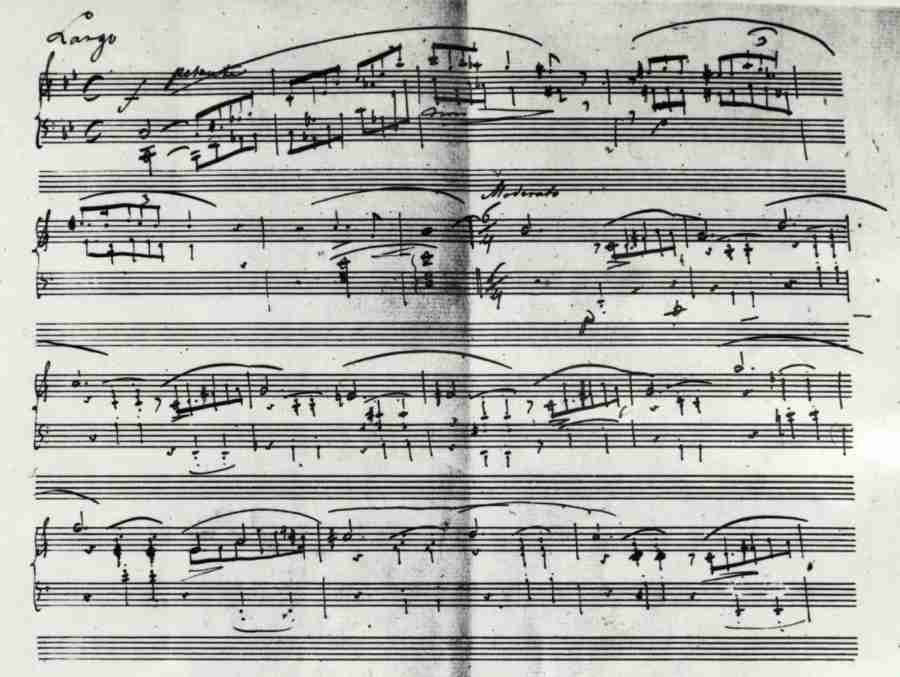발라드는 원래 이야기에 곡조를 붙여서 부른 이야기 시(詩)로서 일종의 민요이다. 이런 종류의 민요는 옛날부터 어느 나라에나 있었던 것이다. 극적임을 특색으로 하는 이 종류의 이야기 시는, 근대에 와서 예술적으로 세련되어 마침내 쇼팽의 발라드와 같은 가사를 갖지 않는 기악을 위한 발라드가 출현하게 되었다.
쇼팽은 서정적 · 서사적 및 극적인 관념을 하나로 합치는 발라드라는 특수한 양식을 창조하였다. 노래 · 론도 · 소나타 및 변주곡 대신에 이 형식을 자기화하여 썼다고 독일의 쇼팽 연구가 라이히텐트리트 박사는 쓰고 있다.

쇼팽 이전에 쇼팽의 그것과 같은 발라드를 쓴 사람은 아무도 없었으며 이후에도 보이지 않는다. 독창적인 작품이다. 그래서 쇼팽의 연구가들이 발라드를 쇼팽의 천재성의 가장 훌륭한 개화(開花)로 간주한 것도 당연하다. 예를 들면 니크스는 「쇼팽의 작품 중 그 형식의 지배, 내용의 아름다움 및 시에 있어서 발라드보다 훌륭한 것은 없다. 이들 작품에 있어서 쇼팽은 예술가로서 힘의 절정에 달하고 있다고 생각한다」고 쓰고 있다.
그런데 쇼팽이 남긴 발라드는 전부 4곡 밖에 없으며 그 수가 너무나도 적은 것이 아쉽다. 4곡 가운데 제1번 g단조 작품 29의 작곡 시기는 1831년이라 간주되고 있다. 제2번 F장조 작품 38은 1838년, 제3번 Ab장조 작품 47은 1841년, 최후의 f단조 작품 52는 이듬해인 1842년에 각각 작곡되었다. 이 4곡은 어느 것이나 폴란드의 애국 시인 미츠키에비치의 서사시에 영감을 얻은 것이라고 쇼팽 자신이 슈만에게 말하고 있지만, 미키비치의 어느 발라드에 자극받아 어느 곡을 썼는지는 분명히 하고 있지 않다. 그러나 대강의 추측은 짐작하고 있다.
먼저 제1번 g단조는 일반적으로 <콘라트 발렌로트>일 것이라고 추정되어 있다. 만일 그렇다고 한다면 다음과 같은 이야기가 이 곡의 배경을 이루고 있다고 상상해도 좋다.
리투아니아가 적십자군에 패배하여 독립을 잃었을 때 7살의 왕자 콘라트 발렌로트는 포로가 되었으나, 적십자군 대장의 사랑을 받아 아들로서 키워졌다. 후에 콘라드는 적십자군 최고의 용맹한 기사가 되었다. 그러나 국경에서 작은 싸움이 벌어졌을 때 시종 바이데로데(실은 리투아니아의 귀족)와 함께 고의로 리투아니아인에 잡혀 신분을 밝히고 환영을 받는다. 그는 이리하여 몰래 2년간을 행복하게 지내고 리투아니아 제1의 미녀와 결혼한다.
그런데 그로부터 오래지 않아 적십자군과 사라센과의 사이에 전쟁이 일어나서 콘라트는 바이데로데의 고육적(苦肉的) 계략에 따라 신부에게 이별을 고하고 출발한다. 그로부터 10년이 지나고 드디어 적십자군의 대장이 된 그는 전에 바이데로데가 일러준 계책대로 적십자군의 재화와 보물을 리투아니아로 옮기고, 수비대의 명력을 약화시킨 다음 리투아니아의 기사와 내통하여 독립을 도모하여 보기 좋게 성공한다. 그러나 그 자신은 배반자로 적십자군에 처형당한다.
이야기는 14세기의 옛일이지만 애국자 쇼팽이 이 발라드에서 감명과 감격을 받았으리라는 것은 쉽사리 상상할 수 있다. 당시의 쇼팽의 조국 폴란드는 적십자군에 점령된 리투아니아와 같은 운명에 빠져 있었다. 하지만 쇼팽은 이 이야기를 그대로 음악으로 말하려고 하는 따위의 어리석음을 범하지는 않고 있다. 쇼팽의 목표는 이야기가 자아내는 정서를 극적으로 암시하는 데 있었을 것이다. 음악적으로 볼 때 이것은 두 개의 주제와 몇 개의 삽입구로 만들어졌음에 불과하다. 그럼에도 불구하고 이 간단한 음의 구조가 한 편의 장편시 이상으로 깊은 감명을 주는 것이다. 참으로 음악의 힘이야말로 불가사의하다 할 것이다.

이 곡의 구조를 간단히 살펴보면, 7마디의 무겁지만 깨끗하고 투명한 서주부 라르고로 곡을 시작하여 모데라토로 들어가 아름답게 파동 치는 제1주제 멜로디가 감개 깊은 듯이 이야기를 시작한다. 그 후에 정열을 숨긴 악구가 계속되고, 그것이 흥분의 도를 더하여 이윽고 화려한 아르페지오로 되는데, 차차 속도와 힘을 떨구어 제2주제(메노 모소)를 준비한다. 이 주제는 쇼팽 특유의 감미로운 슬픔을 품고 말할 수 없이 섬세하고 미묘한 멜로디, 새로운 연결의 경과가 있고 나서 제1주제, 다시 제2주제가 음을 풍부하게 하여 힘차게 재현한다.
여기에서 왈츠 스타일의 리듬을 갖는 8분 음표의 매우 훌륭한 경과가 있고, 그것에 유도되어 이번에는 거꾸로 제2, 제1의 순으로 세 번 주제가 등장하고 문자 그대로 불과 같은 치열한 정열의 프레스토 푸오코에 도달한다. 종결부의 중후한 옥타브와 눈부신 반음계의 경과가 이 비통한 이야기를 맺고 있다.
https://youtu.be/g0Dg_55BirU?si=UDi1WS35bFn2J1t5
Ballad is a kind of folk song as a story poem sung by adding tunes to the original story. This kind of folk song has been in every country since ancient times. This kind of story poem, which is characterized by drama, has become artistically refined in modern times, and finally a ballad for instrumental music that does not have the same lyrics as Chopin's ballad has emerged.
Chopin created a special style of ballad that brought together lyrical, narrative, and dramatic ideas. Instead of songs, rondo, sonatas, and variations, this form was written by magnetization, according to German Chopin researcher Dr. Leichtentritt.
No one wrote a ballad like Chopin's before Chopin, and it is still invisible afterwards. It is an original work. It is no wonder that Chopin's researchers regarded ballads as the greatest enlightenment of Chopin's genius. For example, Nicks writes, "There is nothing better than ballads in Chopin's work in terms of formality, content beauty, and poetry. In these works, I think Chopin is reaching the peak of his power as an artist."
There are only four ballads left by Chopin, and it is regrettable that the number is too small. The composition period of Op.29 in g minor is considered to be 1831, among the four songs. The 2nd F major Op.38 was composed in 1838, the 3rd Ab major Op.47 in 1841, and the last F minor Op.52 in 1842 the following year. Chopin himself tells Schumann that all four of these songs were inspired by the epic poem of the Polish patriotic poet Mickiewicz, but it is not clear which ballad he was inspired to write. I have a rough guess, however.
First, it is generally assumed that the first g minor will be "Konrad Wallenrod". If so, you can imagine the following story constituting the background of this song.
When Lithuania lost its independence after being defeated by the Red Cross, 7-year-old Prince Konrad Wallenrod was taken prisoner, but was raised as a son by the Red Cross captain. Later, Konrad became the most courageous knight of the Red Cross. However, when a small fight broke out at the border, he was deliberately captured by the Lithuanians and welcomed by their servant Widerode (who actually is a Lithuanian nobleman). In this way, he secretly spends two years happily and marries Lithuania's No. 1 beauty.
However, soon after that, a war broke out between the Red Cross and Saracens, and Konrad said goodbye to the priest and departed according to Weiderode's desperate plan. Ten years later, he finally became the leader of the Red Cross army, moved the Red Cross's goods and treasures to Lithuania, weakened the reputation of the garrison, and promoted independence by communicating with the Lithuanian knights. However, he himself is executed by the Red Cross as a traitor.
The story is a long time ago in the 14th century, but it is easy to imagine that Chopin, the patriot, would have been impressed and moved by this ballad. At that time, Chopin's homeland, Poland, was in the same fate as Lithuania, which was occupied by the Red Cross. Chopin, however, does not commit the folly of trying to tell the story in music as it is. Chopin's goal would have been to dramatically imply the emotion the story evokes. Musically, it is just made of two themes and several inserts. Nevertheless, this simple sound structure impresses more than just one feature poem. The power of music is indeed mysterious.
A brief look at the structure of this song begins with the heavy but clean and transparent seoju Largo of seven bars, enters the moderato, and begins the story with a deep emotion of the first theme melody that waves beautifully. After that, the phrase that hides passion continues, and it adds a degree of excitement to eventually become a colorful arpeggios, gradually reducing the speed and power to prepare for the second theme (Meno Moso). This theme contains Chopin's unique sweet sadness, and after the elapse of a new connection, the first theme and the second theme enrich the sound and reproduce it vigorously.
Here is a very good course of eighth notes with waltz-style rhythms, and this time, in reverse, the subject appears three times in the order of second and first, and reaches a presto fuoco with a fierce passion that is literally nothing more than that. This heartbreaking story is told by the heavy octave at the end and the brilliant chromatic course.
'Music Story' 카테고리의 다른 글
| 헨델 오라토리오 "메시아"(The Messiah) (87) | 2024.09.09 |
|---|---|
| 반짝반짝 작은 별(Twinkle, Twinkle, Little Star) (120) | 2024.08.25 |
| 루이지 보케리니(Luigi Boccerini, 1743~1805) (139) | 2024.08.19 |
| 18세기 오케스트라 편성의 특징(Characteristics of 18th-century orchestral organization) (87) | 2024.08.18 |
| 바로크 음악의 대가 헨델(A master of baroque music, Handel) (115) | 2024.08.15 |



